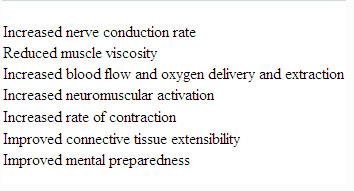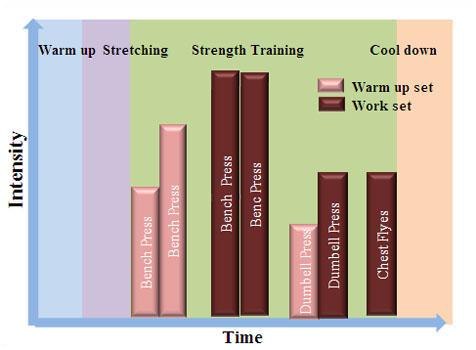Why & How To Warm Up for Weight Training?
June 16 2008
Warm is an integral part of your workout, be it cardio or weight lifting. But many either skip the warm up or just do it wrong. If you think you are one of them, you need help:
What is a warm up?
In simple terms, any sort of activity intended to prepare yourself for your exercise or sport.There are two types of warm up:
Passive warm up: Passive warm up involves warming your muscle or core temperature with saunas, hot baths, warm clothing, and heating pads. Since there is no activity, it is called passive. In contrast, and as you guessed, an active warm involves an activity to raise your core or muscle temperature.
Active warm up: Active warm up can be further divided into types: General warm up & Specific warm up.
A General warm up includes walking, jogging, and calisthenics, hereas the specific warm involves activities which are specific to the sport or the exercise you are preparing for.
A Specific warm up could be short sprints before sprinting, 1 or 2 sets of light-weight bench press before your bench press or stretching your hamstrings (or back of your thighs) before running.
Why warm up?
If you believe in improving performance and preventing injuries, a warm up is always recommended.
Quite a few studies have shown performance increments in the form of increased strength, power and speed in short term (less than 10 seconds) and intermediate (greater than 10 but less than 5 minutes) performances. Research has also shown improvements in endurance events which lasts for more than 5 minutes.

Table: Some of the benefits of warm up are credited to these specific effects. Though universally accepted, the injury prevention part of warm up has less been less convincing in research. And it is beyond the scope of the article to go into these issues. Anyhow, the most recent review on stretching and warm up, do recommend warm up and stretching in preventing injuries.
How To warm up?
Now that you know the basics, I know you can’t to wait to warm up. Here we go:
General warm up: 5- 10 minutes walking, jogging, cycling
Specific warm up: 1, 2 or 3 sets with lighter weights than your work sets on that specific exercise.
The specific warm up provides additional benefits to those provided by general warm up by increasing your nervous system activation. Some people tend to skip the general warm up and start with the specific warm up, and that is fine.

Figure: A typical strength workout (chest emphasis) highlighting warm up set’s intensity and sequence. As shown in the figure, the intensity of warm up should gradually climb. For example, if you are using 100 lbs for dumbbell press, use 50 lbs for the first warm up set and 75 for the second warm up set. Be specific in your warm ups. If you are doing 6 reps for your work sets, keep your warm up set-reps between 6 and 8. If using 10 reps, keep the warm up set.
How to Cool down?
As shown in the figure, you should end your workout with a nice little cool- down. As the name sounds, it “cools” you heart rate and blood pressure back to normal.
A cool down becomes critical for people with heart disease. These folks increase their chances (at least theoretically) of cardiac complications if they miss their cool down.
Things to remember
- As the name sounds, warm up should just be a warm up: Make it too intense, and your work sets or main sets will suffer.
- Always have a recovery period between your warm up and work sets to replenish your energy, and to flush out by- products of reactions in the muscle, like lactic acid and H.
- Use passive techniques to raise or maintain the temperature produced by a active warm up, especially if there is a delay between the warm up and task and/or the weather is cold. A sweat shirt would very well work.
- If ever in doubt about the number of warm up sets needed, pick the larger number!
Related Articles
Commenting is not available in this channel entry.>

